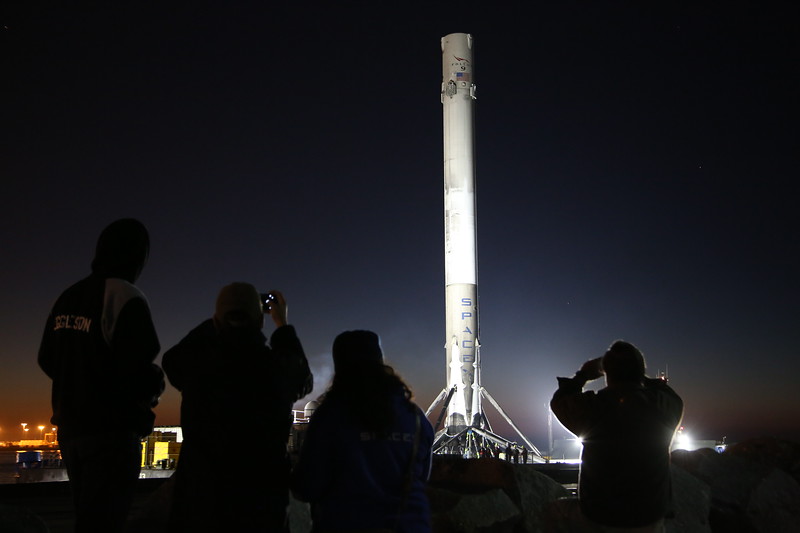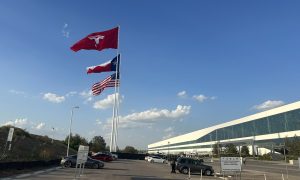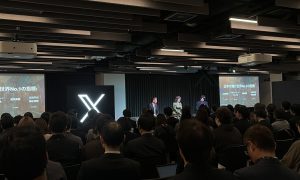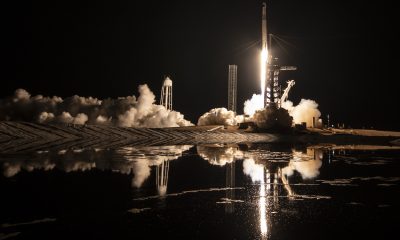News
SpaceX looks to double size of equipment storage site at San Pedro port facility

The Port of Los Angeles Board of Harbor Commissioners will vote Thursday on a SpaceX request to double the space it leases at San Pedro’s outer harbor at the AltaSea marine research facility. All signs are that the petition will be approved.
Space Exploration Technologies Corp. wants to lease 4.6 acres of land and water area along harbor berths 51 to 53 for $23,735 a month, plus insurance and any incidental costs. In addition to extra space, the lease agreement would permit the company to have berthing rights. Some small construction would be involved, too, such as erecting a chain-link fence around the property, creating a concrete rocket-support pedestal, adding an office trailer, building a guard shack, and installing portable restrooms.
In 2016, the San Pedro port and SpaceX entered into their first contract, which was designated to devote two acres to safekeep equipment and store the company’s “Just Read the Instructions” drone ship barge used for the recovery of rockets landing at sea.
Background on SpaceX
SpaceX is the world’s fastest-growing provider of launch services and has over 70 future missions on its manifest, representing over $10 billion in contracts. These include commercial satellite launches as well as NASA and other U.S. government missions.
The company was founded by billionaire CEO Elon Musk in 2002 to revolutionize space technology, with the ultimate goal of enabling people to live on other planets. The company has gained worldwide attention for a series of historic milestones.
- It is the only private company ever to return a spacecraft from low-Earth orbit, which it first accomplished in December 2010.
- In May, 2012, its Dragon spacecraft attached to the International Space Station, exchanged cargo payloads, and returned safely to Earth — a technically challenging feat previously accomplished only by governments.
- Crew Dragon tested its launch abort system in May, 2015, which can provide astronauts with escape capability all the way to orbit.
- On December 21, 2015, the Falcon 9 rocket delivered 11 communications satellites to orbit, and the first-stage returned and landed at Landing Zone 1 -– the first-ever orbital class rocket landing.
- Since then, Dragon has delivered cargo to and from the space station multiple times, providing regular cargo resupply missions for NASA.
- Under a $1.6 billion contract with NASA, SpaceX is flying numerous cargo resupply missions to the International Space Station, for a total of at least 20 flights under the Commercial Resupply Services contract.
- Currently under development is the Falcon Heavy, which will be the world’s most powerful rocket.
What’s ahead for SpaceX and the San Pedro site?
SpaceX plans at least six launches from Vandenberg Air Force Base through 2018. These need at-sea landings, so the San Pedro site will be much in demand for the Hawthorne, CA company’s rocket storage. Additionally, SpaceX company officials have indicated that they intend to launch every two weeks from bases in Florida and California. Thus, the company’s need to park and handle recovered space equipment makes the San Pedro expansion an important element of the company’s future plans.
“Along with Boeing, Catalina Sea Ranch, and the Exploration Vehicle Nautilus, AltaSea and the Port of LA are the home of space exploration and underwater exploration,” Los Angeles Councilman Joe Buscaino. “My hope is that Elon Musk continues to see AltaSea and the Port of Los Angeles as an asset to his operations and continues to grow his company’s presence in San Pedro.”
News
Tesla begins Robotaxi certification push in Arizona: report
Tesla seems serious about expanding its Robotaxi service to several states in the coming months.

Tesla has initiated discussions with Arizona transportation regulators to certify its driverless Robotaxi service in the state, as per a recent report from Bloomberg News. The move follows Tesla’s launch of its Robotaxi pilot program in Austin, Texas, as well as CEO Elon Musk’s recent comments about the service’s expansion in the Bay Area.
The Arizona Department of Transportation confirmed to Bloomberg that Tesla has reached out to begin the certification process for autonomous ride-sharing operations in the state. While details remain limited, the outreach suggests that Tesla is serious about expanding its driverless Robotaxi service to several territories in the coming months.
The Arizona development comes as Tesla prepares to expand its service area in Austin this weekend, as per CEO Elon Musk in a post on X. Musk also stated that Tesla is targeting the San Francisco Bay Area as its next major market, with a potential launch “in a month or two,” pending regulatory approvals.
Tesla first launched its autonomous ride-hailing program on June 22 in Austin with a small fleet of Model Y vehicles, accompanied by a Tesla employee in the passenger seat to monitor safety. While still classified as a test, Musk has said the program will expand to about 1,000 vehicles in the coming months. Tesla will later upgrade its Robotaxi fleet with the Cyercab, a two-seater that is designed without a steering wheel.
Sightings of Cybercab castings around the Giga Texas complex suggests that Tesla may be ramping the initial trial production of the self-driving two-seater. Tesla, for its part, has noted in the past that volume production of the Cybercab is expected to start sometime next year.
In California, Tesla has already applied for a transportation charter-party carrier permit from the state’s Public Utilities Commission. The company is reportedly taking a phased approach to operating in California, with the Robotaxi service starting with pre-arranged rides for employees in vehicles with safety drivers.
News
Tesla sets November 6 date for 2025 Annual Shareholder Meeting
The automaker announced the date on Thursday in a Form 8-K.

Tesla has scheduled its 2025 annual shareholder meeting for November 6, addressing investor concerns that the company was nearing a legal deadline to hold the event.
The automaker announced the date on Thursday in a Form 8-K submitted to the United States Securities and Exchange Commission (SEC). The company also listed a new proposal submission deadline of July 31 for items to be included in the proxy statement.
Tesla’s announcement followed calls from a group of 27 shareholders, including the leaders of large public pension funds, which urged Tesla’s board to formally set the meeting date, as noted in a report from The Wall Street Journal.
The group noted that under Texas law, where Tesla is now incorporated, companies must hold annual meetings within 13 months of the last one if requested by shareholders. Tesla’s previous annual shareholder meeting was held on June 13, 2024, which placed the July 13 deadline in focus.
Tesla originally stated in its 2024 annual report that it would file its proxy statement by the end of April. However, an amended filing on April 30 indicated that the Board of Directors had not yet finalized a meeting date, at least at the time.
The April filing also confirmed that Tesla’s board had formed a special committee to evaluate certain matters related to CEO Elon Musk’s compensation plan. Musk’s CEO performance award remains at the center of a lengthy legal dispute in Delaware, Tesla’s former state of incorporation.
Due to the aftermath of Musk’s legal dispute about his compensation plan in Delaware, he has not been paid for his work at Tesla for several years. Musk, for his part, has noted that he is more concerned about his voting stake in Tesla than his actual salary.
At last year’s annual meeting, TSLA shareholders voted to reapprove Elon Musk’s compensation plan and ratified Tesla’s decision to relocate its legal domicile from Delaware to Texas.
Elon Musk
Grok coming to Tesla vehicles next week “at the latest:” Elon Musk
Grok’s rollout to Tesla vehicles is expected to begin next week at the latest.

Elon Musk announced on Thursday that Grok, the large language model developed by his startup xAI, will soon be available in Tesla vehicles. Grok’s rollout to Tesla vehicles is expected to begin next week at the latest, further deepening the ties between the two Elon Musk-led companies.
Tesla–xAI synergy
Musk confirmed the news on X shortly after livestreaming the release of Grok 4, xAI’s latest large language model. “Grok is coming to Tesla vehicles very soon. Next week at the latest,” Musk wrote in a post on social media platform X.
During the livestream, Musk and several members of the xAI team highlighted several upgrades to Grok 4’s voice capabilities and performance metrics, positioning the LLM as competitive with top-tier models from OpenAI and Google.
The in-vehicle integration of Grok marks a new chapter in Tesla’s AI development. While Tesla has long relied on in-house systems for autonomous driving and energy optimization, Grok’s integration would introduce conversational AI directly into its vehicles’ user experience. This integration could potentially improve customer interaction inside Tesla vehicles.
xAI and Tesla’s collaborative footprint
Grok’s upcoming rollout to Tesla vehicles adds to a growing business relationship between Tesla and xAI. Earlier this year, Tesla disclosed that it generated $198.3 million in revenue from commercial, consulting, and support agreements with xAI, as noted in a report from Bloomberg News. A large portion of that amount, however, came from the sale of Megapack energy storage systems to the artificial intelligence startup.
In July 2023, Musk polled X users about whether Tesla should invest $5 billion in xAI. While no formal investment has been made so far, 68% of poll participants voted yes, and Musk has since stated that the idea would be discussed with Tesla’s board.
-

 Elon Musk1 week ago
Elon Musk1 week agoTesla investors will be shocked by Jim Cramer’s latest assessment
-

 Elon Musk3 days ago
Elon Musk3 days agoElon Musk confirms Grok 4 launch on July 9 with livestream event
-

 Elon Musk17 hours ago
Elon Musk17 hours agoxAI launches Grok 4 with new $300/month SuperGrok Heavy subscription
-

 News7 days ago
News7 days agoTesla Model 3 ranks as the safest new car in Europe for 2025, per Euro NCAP tests
-

 Elon Musk2 weeks ago
Elon Musk2 weeks agoA Tesla just delivered itself to a customer autonomously, Elon Musk confirms
-

 Elon Musk1 week ago
Elon Musk1 week agoxAI’s Memphis data center receives air permit despite community criticism
-

 Elon Musk2 weeks ago
Elon Musk2 weeks agoTesla’s Omead Afshar, known as Elon Musk’s right-hand man, leaves company: reports
-

 News2 weeks ago
News2 weeks agoXiaomi CEO congratulates Tesla on first FSD delivery: “We have to continue learning!”













